The Impact of Millennials on Workplace Culture: A Dissertation
VerifiedAdded on 2021/04/24
|5
|1461
|40
Project
AI Summary
This project proposal outlines a BA dissertation investigating the impact of millennials on shaping workplace culture, with a specific focus on Cisco Systems. The study aims to identify the characteristics of millennials in the workplace, explore their influence on workplace culture, highlight the changes they've brought about within Cisco Systems, and recommend solutions to mitigate potential issues. The research will utilize a mixed-methods approach, including surveys with 140 employees and structured interviews with managers. Data analysis will involve both quantitative (Excel graphs and charts) and qualitative (thematic analysis) methods. The study acknowledges limitations such as budgetary constraints and sample size, while emphasizing the use of pilot testing and test-retest reliability to ensure data validity and reliability. The literature review covers generation theory, the characteristics of millennials, organizational culture models, and relevant research on generational differences in the workplace. The proposal includes a detailed methodology section describing data collection, sampling techniques, data analysis methods, and strategies to ensure validity and reliability.
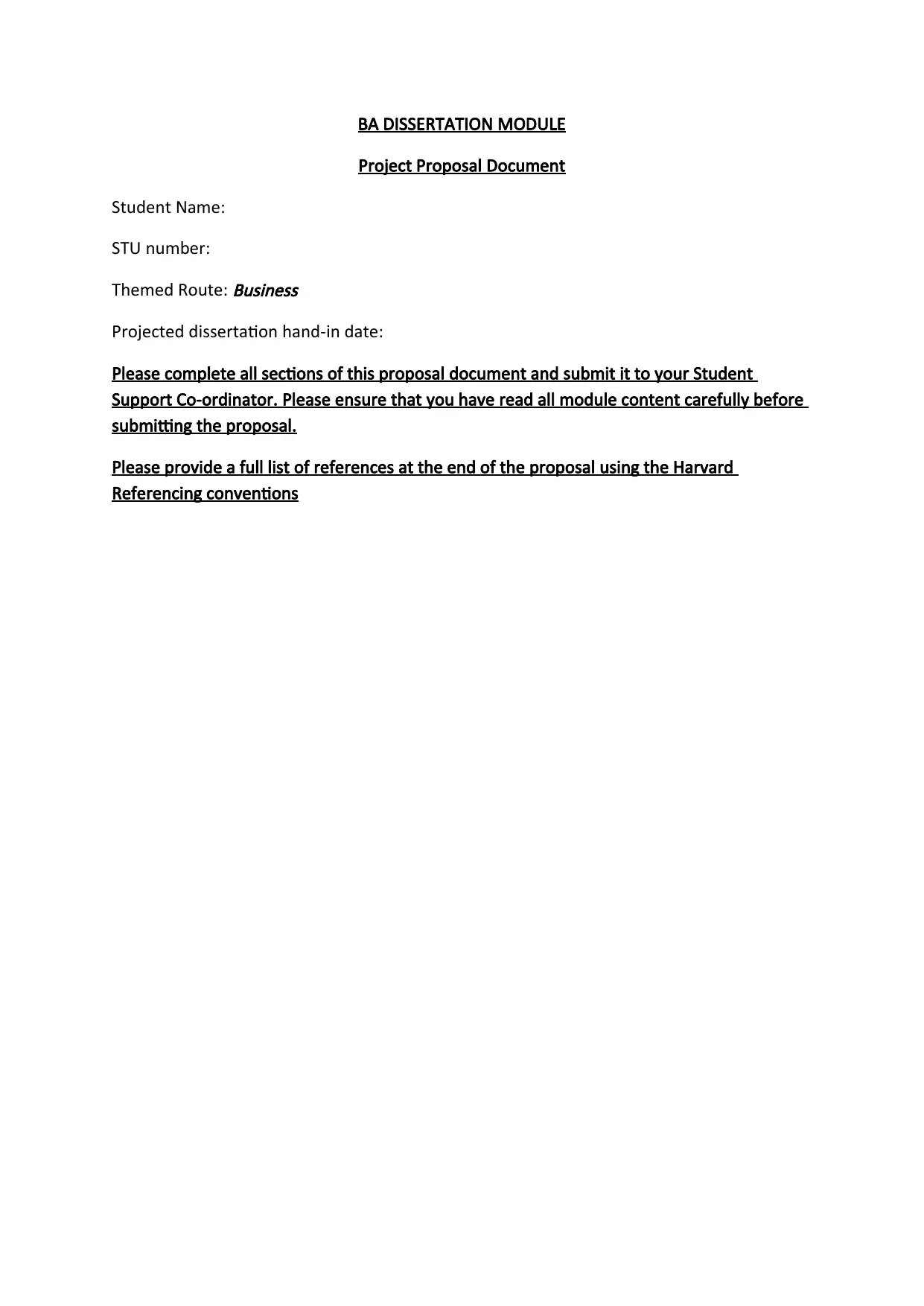
BA DISSERTATION MODULE
Project Proposal Document
Student Name:
STU number:
Themed Route:
Business
Projected dissertation hand-in date:
Please complete all sections of this proposal document and submit it to your Student
Support Co-ordinator. Please ensure that you have read all module content carefully before
submitting the proposal.
Please provide a full list of references at the end of the proposal using the Harvard
Referencing conventions
Project Proposal Document
Student Name:
STU number:
Themed Route:
Business
Projected dissertation hand-in date:
Please complete all sections of this proposal document and submit it to your Student
Support Co-ordinator. Please ensure that you have read all module content carefully before
submitting the proposal.
Please provide a full list of references at the end of the proposal using the Harvard
Referencing conventions
Paraphrase This Document
Need a fresh take? Get an instant paraphrase of this document with our AI Paraphraser
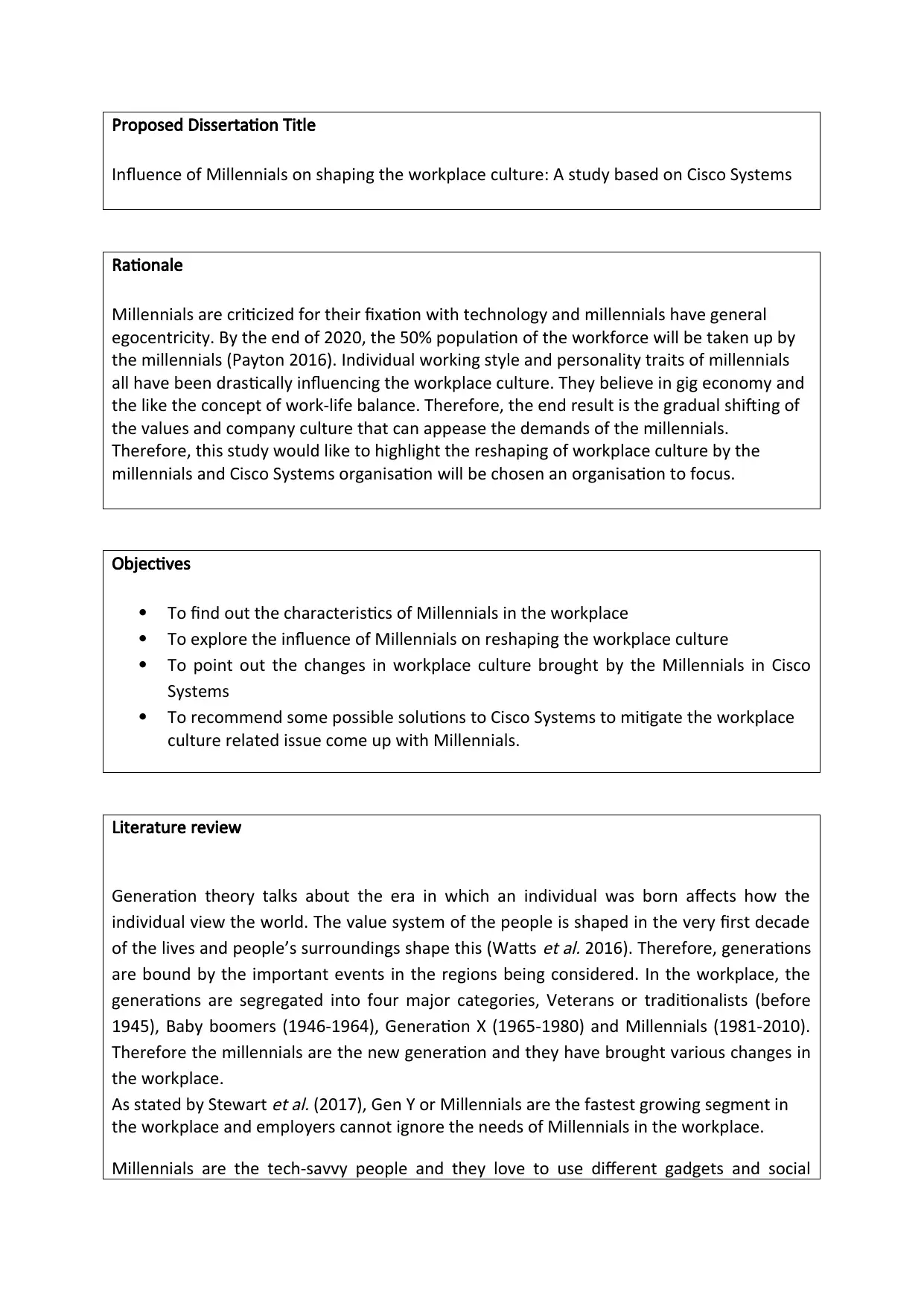
Proposed Dissertation Title
Influence of Millennials on shaping the workplace culture: A study based on Cisco Systems
Rationale
Millennials are criticized for their fixation with technology and millennials have general
egocentricity. By the end of 2020, the 50% population of the workforce will be taken up by
the millennials (Payton 2016). Individual working style and personality traits of millennials
all have been drastically influencing the workplace culture. They believe in gig economy and
the like the concept of work-life balance. Therefore, the end result is the gradual shifting of
the values and company culture that can appease the demands of the millennials.
Therefore, this study would like to highlight the reshaping of workplace culture by the
millennials and Cisco Systems organisation will be chosen an organisation to focus.
Objectives
To find out the characteristics of Millennials in the workplace
To explore the influence of Millennials on reshaping the workplace culture
To point out the changes in workplace culture brought by the Millennials in Cisco
Systems
To recommend some possible solutions to Cisco Systems to mitigate the workplace
culture related issue come up with Millennials.
Literature review
Generation theory talks about the era in which an individual was born affects how the
individual view the world. The value system of the people is shaped in the very first decade
of the lives and people’s surroundings shape this (Watts
et al. 2016). Therefore, generations
are bound by the important events in the regions being considered. In the workplace, the
generations are segregated into four major categories, Veterans or traditionalists (before
1945), Baby boomers (1946-1964), Generation X (1965-1980) and Millennials (1981-2010).
Therefore the millennials are the new generation and they have brought various changes in
the workplace.
As stated by Stewart
et al. (2017), Gen Y or Millennials are the fastest growing segment in
the workplace and employers cannot ignore the needs of Millennials in the workplace.
Millennials are the tech-savvy people and they love to use different gadgets and social
Influence of Millennials on shaping the workplace culture: A study based on Cisco Systems
Rationale
Millennials are criticized for their fixation with technology and millennials have general
egocentricity. By the end of 2020, the 50% population of the workforce will be taken up by
the millennials (Payton 2016). Individual working style and personality traits of millennials
all have been drastically influencing the workplace culture. They believe in gig economy and
the like the concept of work-life balance. Therefore, the end result is the gradual shifting of
the values and company culture that can appease the demands of the millennials.
Therefore, this study would like to highlight the reshaping of workplace culture by the
millennials and Cisco Systems organisation will be chosen an organisation to focus.
Objectives
To find out the characteristics of Millennials in the workplace
To explore the influence of Millennials on reshaping the workplace culture
To point out the changes in workplace culture brought by the Millennials in Cisco
Systems
To recommend some possible solutions to Cisco Systems to mitigate the workplace
culture related issue come up with Millennials.
Literature review
Generation theory talks about the era in which an individual was born affects how the
individual view the world. The value system of the people is shaped in the very first decade
of the lives and people’s surroundings shape this (Watts
et al. 2016). Therefore, generations
are bound by the important events in the regions being considered. In the workplace, the
generations are segregated into four major categories, Veterans or traditionalists (before
1945), Baby boomers (1946-1964), Generation X (1965-1980) and Millennials (1981-2010).
Therefore the millennials are the new generation and they have brought various changes in
the workplace.
As stated by Stewart
et al. (2017), Gen Y or Millennials are the fastest growing segment in
the workplace and employers cannot ignore the needs of Millennials in the workplace.
Millennials are the tech-savvy people and they love to use different gadgets and social
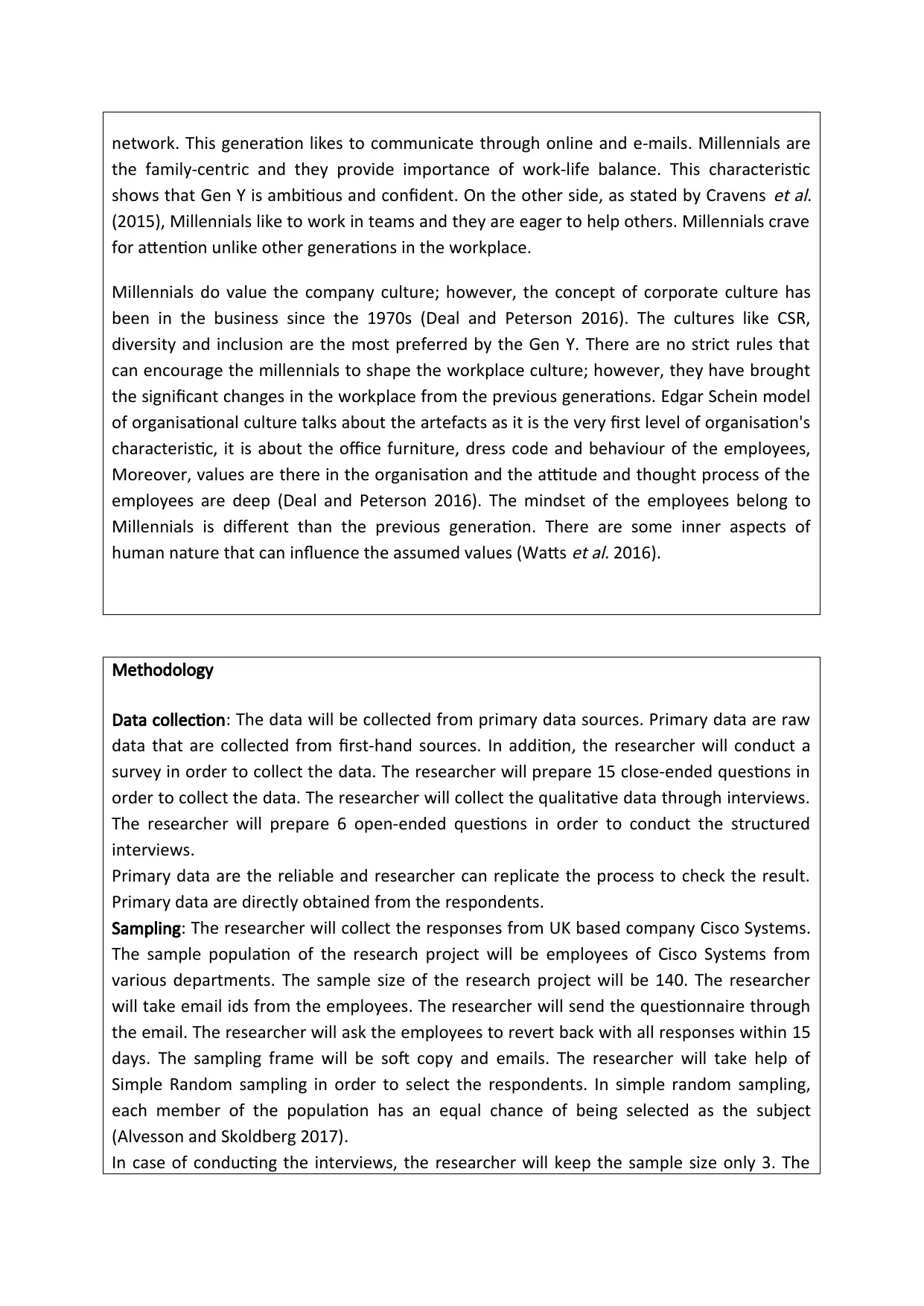
network. This generation likes to communicate through online and e-mails. Millennials are
the family-centric and they provide importance of work-life balance. This characteristic
shows that Gen Y is ambitious and confident. On the other side, as stated by Cravens
et al.
(2015), Millennials like to work in teams and they are eager to help others. Millennials crave
for attention unlike other generations in the workplace.
Millennials do value the company culture; however, the concept of corporate culture has
been in the business since the 1970s (Deal and Peterson 2016). The cultures like CSR,
diversity and inclusion are the most preferred by the Gen Y. There are no strict rules that
can encourage the millennials to shape the workplace culture; however, they have brought
the significant changes in the workplace from the previous generations. Edgar Schein model
of organisational culture talks about the artefacts as it is the very first level of organisation's
characteristic, it is about the office furniture, dress code and behaviour of the employees,
Moreover, values are there in the organisation and the attitude and thought process of the
employees are deep (Deal and Peterson 2016). The mindset of the employees belong to
Millennials is different than the previous generation. There are some inner aspects of
human nature that can influence the assumed values (Watts
et al. 2016).
Methodology
Data collection: The data will be collected from primary data sources. Primary data are raw
data that are collected from first-hand sources. In addition, the researcher will conduct a
survey in order to collect the data. The researcher will prepare 15 close-ended questions in
order to collect the data. The researcher will collect the qualitative data through interviews.
The researcher will prepare 6 open-ended questions in order to conduct the structured
interviews.
Primary data are the reliable and researcher can replicate the process to check the result.
Primary data are directly obtained from the respondents.
Sampling: The researcher will collect the responses from UK based company Cisco Systems.
The sample population of the research project will be employees of Cisco Systems from
various departments. The sample size of the research project will be 140. The researcher
will take email ids from the employees. The researcher will send the questionnaire through
the email. The researcher will ask the employees to revert back with all responses within 15
days. The sampling frame will be soft copy and emails. The researcher will take help of
Simple Random sampling in order to select the respondents. In simple random sampling,
each member of the population has an equal chance of being selected as the subject
(Alvesson and Skoldberg 2017).
In case of conducting the interviews, the researcher will keep the sample size only 3. The
the family-centric and they provide importance of work-life balance. This characteristic
shows that Gen Y is ambitious and confident. On the other side, as stated by Cravens
et al.
(2015), Millennials like to work in teams and they are eager to help others. Millennials crave
for attention unlike other generations in the workplace.
Millennials do value the company culture; however, the concept of corporate culture has
been in the business since the 1970s (Deal and Peterson 2016). The cultures like CSR,
diversity and inclusion are the most preferred by the Gen Y. There are no strict rules that
can encourage the millennials to shape the workplace culture; however, they have brought
the significant changes in the workplace from the previous generations. Edgar Schein model
of organisational culture talks about the artefacts as it is the very first level of organisation's
characteristic, it is about the office furniture, dress code and behaviour of the employees,
Moreover, values are there in the organisation and the attitude and thought process of the
employees are deep (Deal and Peterson 2016). The mindset of the employees belong to
Millennials is different than the previous generation. There are some inner aspects of
human nature that can influence the assumed values (Watts
et al. 2016).
Methodology
Data collection: The data will be collected from primary data sources. Primary data are raw
data that are collected from first-hand sources. In addition, the researcher will conduct a
survey in order to collect the data. The researcher will prepare 15 close-ended questions in
order to collect the data. The researcher will collect the qualitative data through interviews.
The researcher will prepare 6 open-ended questions in order to conduct the structured
interviews.
Primary data are the reliable and researcher can replicate the process to check the result.
Primary data are directly obtained from the respondents.
Sampling: The researcher will collect the responses from UK based company Cisco Systems.
The sample population of the research project will be employees of Cisco Systems from
various departments. The sample size of the research project will be 140. The researcher
will take email ids from the employees. The researcher will send the questionnaire through
the email. The researcher will ask the employees to revert back with all responses within 15
days. The sampling frame will be soft copy and emails. The researcher will take help of
Simple Random sampling in order to select the respondents. In simple random sampling,
each member of the population has an equal chance of being selected as the subject
(Alvesson and Skoldberg 2017).
In case of conducting the interviews, the researcher will keep the sample size only 3. The
⊘ This is a preview!⊘
Do you want full access?
Subscribe today to unlock all pages.

Trusted by 1+ million students worldwide
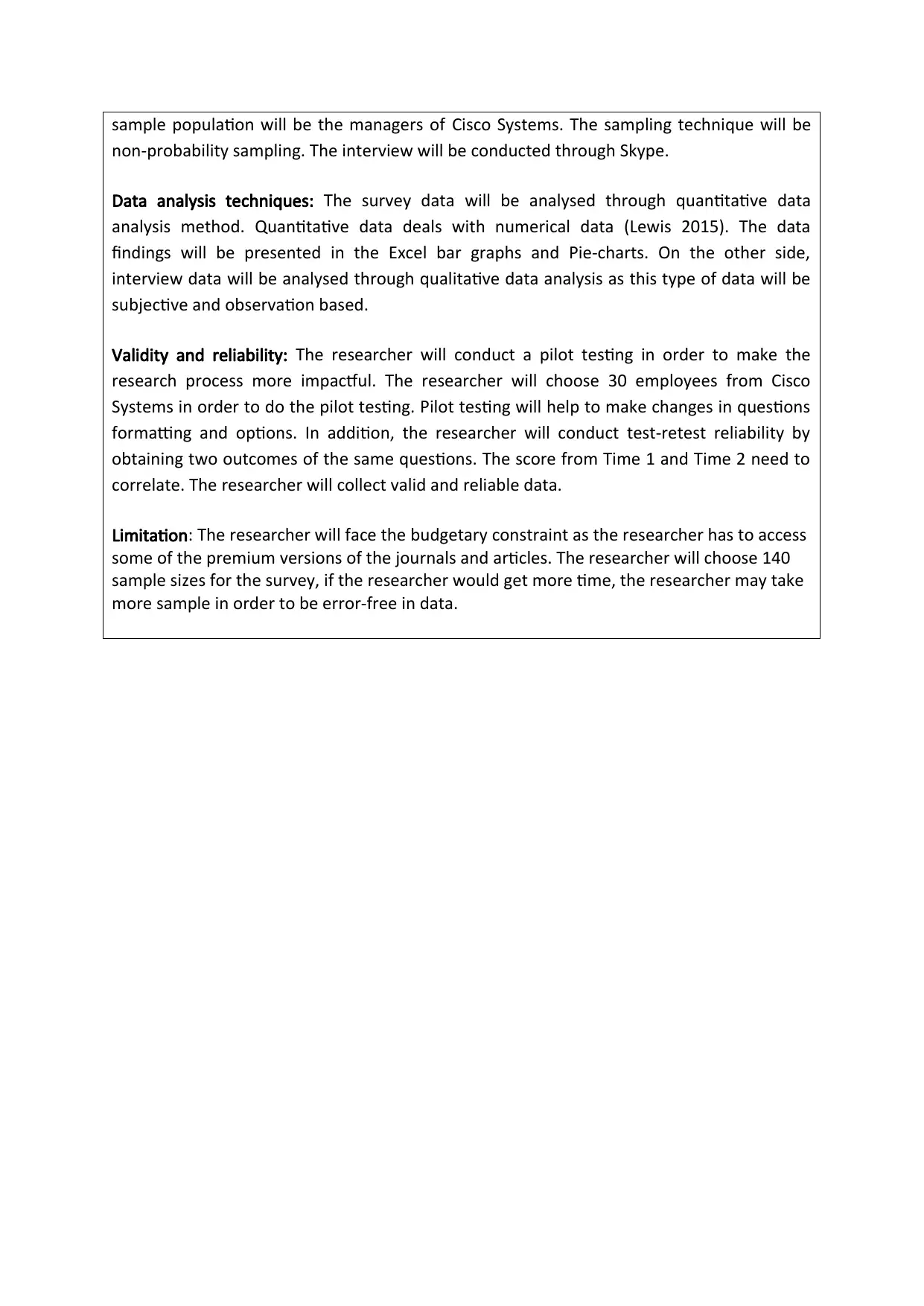
sample population will be the managers of Cisco Systems. The sampling technique will be
non-probability sampling. The interview will be conducted through Skype.
Data analysis techniques: The survey data will be analysed through quantitative data
analysis method. Quantitative data deals with numerical data (Lewis 2015). The data
findings will be presented in the Excel bar graphs and Pie-charts. On the other side,
interview data will be analysed through qualitative data analysis as this type of data will be
subjective and observation based.
Validity and reliability: The researcher will conduct a pilot testing in order to make the
research process more impactful. The researcher will choose 30 employees from Cisco
Systems in order to do the pilot testing. Pilot testing will help to make changes in questions
formatting and options. In addition, the researcher will conduct test-retest reliability by
obtaining two outcomes of the same questions. The score from Time 1 and Time 2 need to
correlate. The researcher will collect valid and reliable data.
Limitation: The researcher will face the budgetary constraint as the researcher has to access
some of the premium versions of the journals and articles. The researcher will choose 140
sample sizes for the survey, if the researcher would get more time, the researcher may take
more sample in order to be error-free in data.
non-probability sampling. The interview will be conducted through Skype.
Data analysis techniques: The survey data will be analysed through quantitative data
analysis method. Quantitative data deals with numerical data (Lewis 2015). The data
findings will be presented in the Excel bar graphs and Pie-charts. On the other side,
interview data will be analysed through qualitative data analysis as this type of data will be
subjective and observation based.
Validity and reliability: The researcher will conduct a pilot testing in order to make the
research process more impactful. The researcher will choose 30 employees from Cisco
Systems in order to do the pilot testing. Pilot testing will help to make changes in questions
formatting and options. In addition, the researcher will conduct test-retest reliability by
obtaining two outcomes of the same questions. The score from Time 1 and Time 2 need to
correlate. The researcher will collect valid and reliable data.
Limitation: The researcher will face the budgetary constraint as the researcher has to access
some of the premium versions of the journals and articles. The researcher will choose 140
sample sizes for the survey, if the researcher would get more time, the researcher may take
more sample in order to be error-free in data.
Paraphrase This Document
Need a fresh take? Get an instant paraphrase of this document with our AI Paraphraser
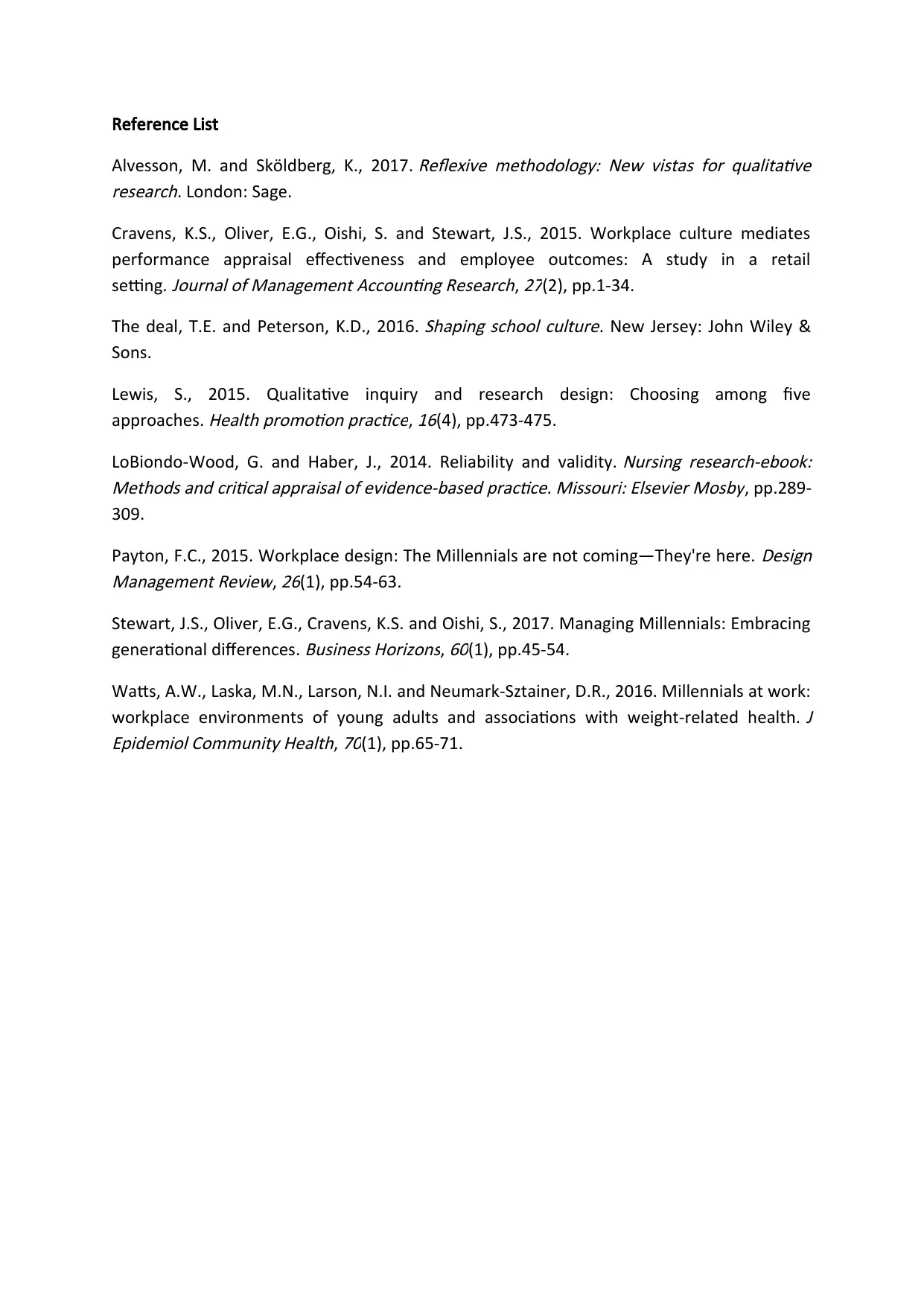
Reference List
Alvesson, M. and Sköldberg, K., 2017.
Reflexive methodology: New vistas for qualitative
research. London: Sage.
Cravens, K.S., Oliver, E.G., Oishi, S. and Stewart, J.S., 2015. Workplace culture mediates
performance appraisal effectiveness and employee outcomes: A study in a retail
setting.
Journal of Management Accounting Research,
27(2), pp.1-34.
The deal, T.E. and Peterson, K.D., 2016.
Shaping school culture. New Jersey: John Wiley &
Sons.
Lewis, S., 2015. Qualitative inquiry and research design: Choosing among five
approaches.
Health promotion practice,
16(4), pp.473-475.
LoBiondo-Wood, G. and Haber, J., 2014. Reliability and validity.
Nursing research-ebook:
Methods and critical appraisal of evidence-based practice. Missouri: Elsevier Mosby, pp.289-
309.
Payton, F.C., 2015. Workplace design: The Millennials are not coming—They're here.
Design
Management Review,
26(1), pp.54-63.
Stewart, J.S., Oliver, E.G., Cravens, K.S. and Oishi, S., 2017. Managing Millennials: Embracing
generational differences.
Business Horizons,
60(1), pp.45-54.
Watts, A.W., Laska, M.N., Larson, N.I. and Neumark-Sztainer, D.R., 2016. Millennials at work:
workplace environments of young adults and associations with weight-related health.
J
Epidemiol Community Health,
70(1), pp.65-71.
Alvesson, M. and Sköldberg, K., 2017.
Reflexive methodology: New vistas for qualitative
research. London: Sage.
Cravens, K.S., Oliver, E.G., Oishi, S. and Stewart, J.S., 2015. Workplace culture mediates
performance appraisal effectiveness and employee outcomes: A study in a retail
setting.
Journal of Management Accounting Research,
27(2), pp.1-34.
The deal, T.E. and Peterson, K.D., 2016.
Shaping school culture. New Jersey: John Wiley &
Sons.
Lewis, S., 2015. Qualitative inquiry and research design: Choosing among five
approaches.
Health promotion practice,
16(4), pp.473-475.
LoBiondo-Wood, G. and Haber, J., 2014. Reliability and validity.
Nursing research-ebook:
Methods and critical appraisal of evidence-based practice. Missouri: Elsevier Mosby, pp.289-
309.
Payton, F.C., 2015. Workplace design: The Millennials are not coming—They're here.
Design
Management Review,
26(1), pp.54-63.
Stewart, J.S., Oliver, E.G., Cravens, K.S. and Oishi, S., 2017. Managing Millennials: Embracing
generational differences.
Business Horizons,
60(1), pp.45-54.
Watts, A.W., Laska, M.N., Larson, N.I. and Neumark-Sztainer, D.R., 2016. Millennials at work:
workplace environments of young adults and associations with weight-related health.
J
Epidemiol Community Health,
70(1), pp.65-71.
1 out of 5
Your All-in-One AI-Powered Toolkit for Academic Success.
+13062052269
info@desklib.com
Available 24*7 on WhatsApp / Email
![[object Object]](/_next/static/media/star-bottom.7253800d.svg)
Unlock your academic potential
Copyright © 2020–2025 A2Z Services. All Rights Reserved. Developed and managed by ZUCOL.


